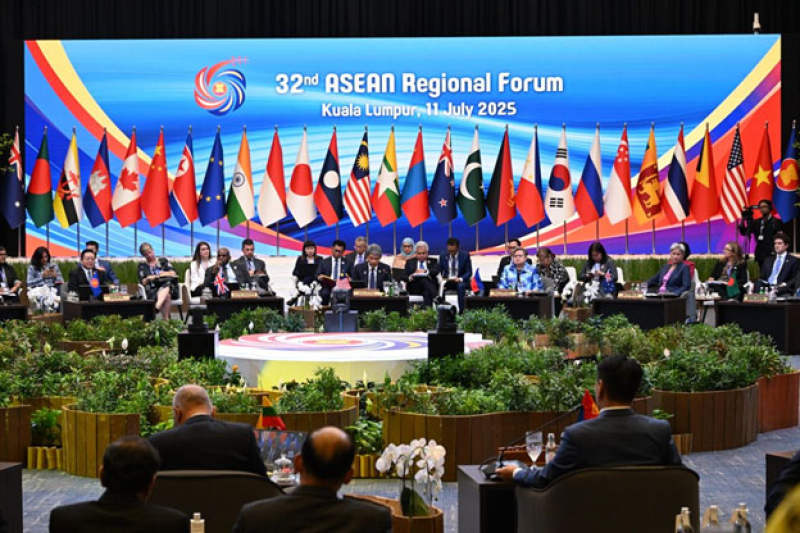- Interim govt plans promotion drive to boost bureaucracy |
- Pakistan Reels Under Monsoon Deluge as Death Toll Climbs |
- Prof Yunus stresses transparency in finalising July Charter |
- Fakhrul suspects plot to thwart February polls |
- UN Warns Gaza Children Face Starvation Amid Total Collapse |
Fractured World Needs Peace, Not More Military Alliances

Credit: ASEAN
Who in Asia would ask for an Asian NATO? Past attempts to develop Asian security alliances under US leadership have not been successful. The two treaty organisations created by the US in the 1950s to counter Communism—CENTO and SEATO—have long since dissolved.
Indo-China was overtaken by Communist forces despite American and allied interventions, large-scale bombings, widespread devastation, and millions of deaths. Ironically, the countries once targeted by US-led interventions are now thriving, having adopted liberal economic policies. Today, Indo-Chinese nations maintain mutually beneficial economic and political relations with China.
China has invested billions in infrastructure across the Indo-China region under its Belt and Road Initiative (BRI), with tangible economic benefits. Over USD 1 billion has been invested regionally and beyond, aiming to create shared prosperity. These deepening economic ties arguably make new military alliances unnecessary.
In Central Asia, following the ouster of the Shah in Iran, the region has become a quagmire for US and Western interests. Despite enormous spending, repeated military interventions, and millions of deaths—mostly civilians—peace remains elusive across the area once covered by CENTO.
Meanwhile, ASEAN’s ten member countries have developed intertwined economic relationships with China, largely benefiting from a bilateral free trade agreement. Today, China has replaced the US as ASEAN’s largest trading partner, with bilateral trade nearing USD 1 billion. ASEAN goods, including fresh produce, have easy access to China’s vast market, while millions of Chinese tourists visit ASEAN countries. Student exchanges also flourish, with Chinese students seeking education particularly in Singapore and Malaysia.
Admittedly, there are potential flashpoints in the South China Sea, often highlighted—or exaggerated—by Western media. However, given the strengthening bilateral economic ties and deep historical relationships between ASEAN and China, regional countries are likely to resolve disputes on their own. No ASEAN country has proposed forming a military alliance to settle their differences.
It’s notable that within days of the US imposing tariffs on Australian copper and pharmaceuticals, Australia’s Prime Minister Albanese visited China with a large trade delegation. China is Australia’s largest trading partner, and neither side seems eager to risk this economic relationship by pursuing defence arrangements targeting China. In 2024, Australia’s exports to China totalled AUD 196 billion, significantly contributing to Australian living standards.
The QUAD—comprising the US, Japan, Australia, and India—was once heavily promoted but has recently faded from prominence.
China, while nuclear-armed, maintains a no-first-use policy. North Korea’s nuclear strategy focuses on deterrence. In this context, promoting a NATO-style alliance in East or Southeast Asia appears excessive and provocative. China has only one overseas military base (in Djibouti), aimed at countering piracy. North Korea has none. Both countries keep their military forces within their borders, unlike the US, which maintains thousands of troops stationed around China. The US pivot to Asia clearly targets China, not the other way around.
The best path to reducing real and perceived tensions—some deliberately inflamed—would be to encourage direct dialogue among all parties. A fractured world needs peace, not further conflict, to advance human progress.
What’s needed are alliances that promote infrastructure development, address climate change and rising sea levels, eliminate extreme poverty, and build a better world for current and future generations.
Past US military interventions in the region have not produced peace. Instead, they slowed national development, caused thousands of deaths, and left millions maimed. The painful lessons of the past must guide future policies.
Dr Palitha Kohona is the former Chief of the UN Treaty Section, a former Permanent Representative of Sri Lanka to the United Nations, and former Ambassador to China.

